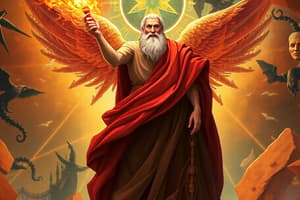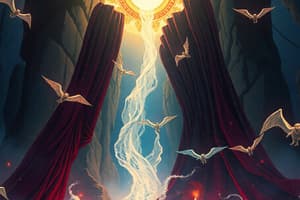Podcast
Questions and Answers
How does Dante's use of language in Paradiso reflect its setting?
How does Dante's use of language in Paradiso reflect its setting?
The language used in Paradiso reflects perfection and divine harmony, employing a poetic, solemn, and symbolic style that aligns with the celestial themes.
In Purgatorio, what is the symbolic importance of the mountain?
In Purgatorio, what is the symbolic importance of the mountain?
The mountain in Purgatorio symbolizes the ascent towards spiritual purification and salvation, representing both the challenges and the hope involved in the soul's journey.
What is the significance of light and darkness symbolism?
What is the significance of light and darkness symbolism?
Light symbolizes divine knowledge and salvation, growing as one ascends. Darkness represents the state of being in hell.
What is meant of the 'resurga' in Canto I?
What is meant of the 'resurga' in Canto I?
What does Virgil's hastiness in securing the penitential cincture symbolize?
What does Virgil's hastiness in securing the penitential cincture symbolize?
How does Dante use Calliope in his work?
How does Dante use Calliope in his work?
How does Dante describe the gates of Purgatorio?
How does Dante describe the gates of Purgatorio?
How does Dante use different styles for his work?
How does Dante use different styles for his work?
What do the four stars symbolize?
What do the four stars symbolize?
How salvation is attained for man, according to Dante?
How salvation is attained for man, according to Dante?
Flashcards
Inferno
Inferno
From the first to the ninth circle are the damned
Purgatorio
Purgatorio
The place where people are cleansed of their sins
Paradiso
Paradiso
It is the area where the blessed souls are located
Registro Mediante
Registro Mediante
Signup and view all the flashcards
Purgatorio as a mountain
Purgatorio as a mountain
Signup and view all the flashcards
Calliope
Calliope
Signup and view all the flashcards
Symbolic Landscape
Symbolic Landscape
Signup and view all the flashcards
Gate of Purgatory
Gate of Purgatory
Signup and view all the flashcards
Catone
Catone
Signup and view all the flashcards
Arrival on the beach
Arrival on the beach
Signup and view all the flashcards
Study Notes
- The text focuses on Dante's "Inferno," "Purgatorio," and "Paradiso"
- "Inferno" contains nine circles where the damned are located
- "Purgatorio" is composed of seven ledges that hold purifying souls
- "Paradiso" develops across nine heavens that is home to blessed souls
Levels of Style
-
Dante uses an elevated style to address important topics
-
The important topics include divine dignity, soul wisdom, and the concept of divine justice
-
The language is poetic, solemn, and full of symbolism
-
The style is present in "Paradiso," where the language reflects perfection and divine harmony
-
Dante adopts a style that expresses complex content without overly solemn tones
-
The style is accessible compared to that of "Paradiso"
-
It is used mainly in "Inferno" and "Purgatorio," which deal with sin, purification, and redemption
-
The record remains high but needs greater reader comprehension
-
Dante adopts a simpler tone, close to spoken word, to describe earthly situations or to speak of humble characters
-
The style appears often in dialogues between the damned or blessed, as arguments of daily life are discussed
-
The language remains poetic but is less sophisticated than the other registers
Canto I of Dante's Purgatorio
- The first few verses that open the second canticle are dedicated to the proem and invocation to the Muses
- Calliope is the specific Muse invoked, named "dalla bella voce," who protected epic poetry
- This is to underline the change of topic and style of the cantica, according to the tripartition of the styles of medieval poetics
- Virgil is the model of reference
Summary of Canto I
-
It opens with Dante and Virgil landing on the beach at the foot of Mount Purgatory
-
Dante is halfway through his journey from the trip to Hell and his ascent to Paradise
-
Dante describes the scene at the beginning of Canto with a bright and serene landscape
-
The description is a contrast to the darkness of Inferno
-
Purgatory is represented as a place of hope, where souls are destined to purify and ascend towards Paradise
-
The purging souls are described as souls of those who regret their sins
-
Initially, Dante does not see any souls, but hears sounds of celestial songs coming from inside Purgatory
-
The mountain is a symbol of spiritual ascent, a path that leads to enlightenment and purification
-
Souls are in a place where performing acts of penance and hope is still possible
-
Dante hears some angels singing a welcome to souls entering Purgatory
-
Their music a sign of imminent purification
-
Dante is surprised by the beauty of the song, which evokes God's greatness and love
-
Virgil explains to Dante that Purgatory is divided into various frames (purification plans)
-
Before starting the journey, they must pass through the gate of Purgatory, guarded by an angel
-
The door is decorated with images that tell the story of salvation and creation
Key Symbolism
- Purgatory as a Mountain represents the path to redemption and salvation
- Its shape symbolizes the difficulty of the spiritual path, but also the possibility of ascension
- Light symbolizes divine knowledge and salvation, growing as one ascends
- The darkness of Hell is left behind
Additional Points
-
The canto opens with a description of the landscape as Dante and Virgil land on a beach
-
The beach is after going through hell; Dante finds himself in Purgatory.
-
Dante is now in Purgatory, a place of purification where souls atone for their sins before ascending to Paradise
-
The scene is bright and serene, a stark contrast to the darkness and sorrow of Hell
-
The light here is described as a ray of sunshine that spreads throughout the area.
-
Dante and Virgil are greeted by a chorus of angels who sing hymns to God
-
The angels' song symbolizes heavenly music that seems to celebrate the salvation of souls
-
The angel voices gives Dante a sense of peace and serenity, a symbol that Purgatory is a place of hope and not eternal suffering like Hell
-
Dante describes the song as praise to divine mercy
-
Dante and Virgil begin to climb towards the mountain of Purgatory
-
The mountain is high and arduous, also the symbol of redemption and the path to salvation
-
Purgatory is divided into different levels (the frames) where souls atone for the various sins
-
Each frame represents a specific sin to purify
-
Dante has not described the purging sinners, but the environment is already a sign that ascent to Paradise is possible
-
Dante and Virgil approach the Gate of Purgatory, which is guarded by an angel
-
The door is described as a shining door, a symbol of salvation
-
The angel guarding it is a guardian of divine justice and represents the mercy of God
-
This shows that only those who have sincerely repented can enter Purgatory and purify themselves
-
The door is decorated with scenes depicting biblical episodes, especially creation and salvation
-
Dante expresses his amazement and reflection on the path he is embarking on in the end
-
Virgil reassures him and explains that rising towards salvation is possible, but will require effort and dedication
-
The scene closes with Virgil's invitation to advance towards purification, marking the beginning of Dante's journey through Purgatory
Introduction
- Canto I of Purgatory opens the second Cantico and is the doorway to the journey of Dante to the second of the afterlife realms
- The first canto which is Purgatory, is important because it signals Dante's transition from a realm of despair to one of hope, symbolized by the ascent from Hell to Purgatory
- The concept of repentance is introduced, with souls ready to purify themselves of their sins
- The word "resurga" means the resurrection of souls, their purification path, and expiation of sins with the goal of obtaining salvation and ascending to Paradise
- The space-time setting reinforces this intention: it is Easter Sunday, the day Christians celebrate the resurrection of Christ, and Dante and Virgil are enveloped in the light of dawn
- The setting mirrors the light of divine Grace that embraces the souls, saved from eternal damnation, and symbolizes hope after darkness
- The setting is serene and faithful, which translates into an elevated style
Characters
- Canto I features Dante and Virgil
Narrative Summary
- Dante is ready to sing with more calm after leaving the terrible sea of Hell, about Purgatory, where the soul is purified to access Paradise
- The poet invokes the help of the Muse Calliope to assist him with the same singing which defeated the Piche
Canto I Analysis
- Dante begins the second canticle with an invocation to Calliope
- Calliope is the muse and protector of epic poetry, and was invoked by Virgil in Book IX of the Aeneid
- Drawing this comparison, Dante references the myth of the daughters of Pierus who challenged the Muses to a singing match
- Calliope won to transform them into magpies, condemning them to screech for eternity
- Dante puts Canto I of Purgatory, and the entire Cantico under the warning against pride
- Without humility, the salvation of souls, the ultimate goal of afterlife, cannot be achieved
Allegories
- Dante introduces the constellation that symbolize the four cardinal virtues of prudence, justice, strength, and temperance qualities
- Cato represents freedom
- When Virgil hurriedly uses the penitential to represent humility.
- Virgil is a symbol of human reason
- Dante realizes that rationality, goodness, and intelligence are not enough to guarantee the salvation of man
- Divine power is needed, which Virgil could not receive because he was pagan
Studying That Suits You
Use AI to generate personalized quizzes and flashcards to suit your learning preferences.




